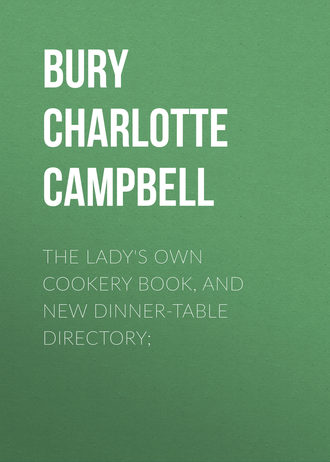 полная версия
полная версияThe Lady's Own Cookery Book, and New Dinner-Table Directory;

Charlotte Campbell Bury
The Lady's Own Cookery Book, and New Dinner-Table Directory; / In Which will Be Found a Large Collection of Original Receipts. 3rd ed
PREFACE
The Receipts composing the Volume here submitted to the Public have been collected under peculiarly favourable circumstances by a Lady of distinction, whose productions in the lighter department of literature entitle her to a place among the most successful writers of the present day. Moving in the first circles of rank and fashion, her associations have qualified her to furnish directions adapted to the manners and taste of the most refined Luxury; whilst long and attentive observation, and the communications of an extensive acquaintance, have enabled her equally to accommodate them to the use of persons of less ample means and of simpler and more economical habits.
When the task of arranging the mass of materials thus accumulated devolved upon the Editor, it became his study to give to them such a form as should be most convenient for constant reference. A glance at the "Contents," which might with equal propriety be denominated an Index, will, he flatters himself, convince the reader that this object has been accomplished. It will there be seen that the Receipts, upwards of Sixteen Hundred in number, are classed under Eleven distinct Heads, each of which is arranged in alphabetical order – a method which confers on this Volume a decided advantage over every other work of the kind, inasmuch as it affords all the facilities of a Dictionary, without being liable to the unpleasant intermixture of heterogeneous matters which cannot be avoided in that form of arrangement.
The intimate connexion between the Science of Cookery and the Science of Health, the sympathies subsisting between every part of the system and the stomach, and the absolute necessity of strict attention not less to the manner of preparing the alimentary substances offered to that organ than to their quality and quantity, have been of late years so repeatedly and so forcibly urged by professional pens, that there needs no argument here to prove the utility of a safe Guide and Director in so important a department of domestic economy as that which is the subject of this Volume. In many more cases, indeed, than the uninitiated would imagine, is the healthy tone of the stomach dependent on the proper preparation of the food, the healthy tone of the body in general on that of the stomach, and the healthy tone of the mind on that of the body: consequently the first of these conditions ought to command the vigilance and solicitude of all who are desirous of securing the true enjoyment of life – the mens sana in corpore sano.
The professed Cook may perhaps be disposed to form a mean estimate of these pages, because few, or no learned, or technical, terms are employed in them; but this circumstance, so far from operating to the disparagement of the work, must prove a strong recommendation to the Public in general. The chief aim, in fact, of the noble Authoress has been to furnish such plain directions, in every branch of the culinary art, as shall be really useful to English masters and English servants, and to the humble but earnest practitioner. Let those who may desire to put this collection of receipts to the test only give them a fair trial, neither trusting to conceited servants, who, despising all other methods, obstinately adhere to their own, and then lay the blame of failure upon the directions; nor committing their execution to careless ones, who neglect the means prescribed for success, either in regard to time, quantities, or cleanliness; and the result will not fail to afford satisfactory evidence of their pleasant qualities and practical utility.
GENERAL DIRECTIONS
The following directions may appear trite and common, but it is of the greatest consequence that they be strictly observed:
Attend to minute cleanliness. Never wipe a dish, bowl, or pan, with a half dirty napkin, or give the vessel a mere rinse in water and think that it is then fit for use. See that it be dried and pure from all smell before you put in any ingredient.
Never use the hands when it is possible to avoid it; and, when you do, have a clean basin of water to dip them in, and wipe them thoroughly several times while at work, as in mixing dough, &c.
Use silver or wooden spoons; the latter are best for all confectionery and puddings. Take care that the various spoons, skewers, and knives, be not used promiscuously for cookery and confectionery, or even for different dishes of the same sort.
If an onion is cut with any knife, or lies near any article of kitchen use, that article is not fit for service till it has been duly scoured and laid in the open air. The same remark applies to very many strong kitchen herbs. This point is scarcely ever enough attended to.
In measuring quantities, be extremely exact, having always some particular vessel set apart for each ingredient (best of earthenware, because such cannot retain any smell) wherewith to ascertain your quantities. Do nothing by guess, how practised soever you may deem yourself in the art: nor say "Oh! I want none of your measures for such a thing as a little seasoning," taking a pinch here and there. Be assured you will never in that way make a dish, or a sauce, twice in the same manner; it may be good by chance, but it will always be a chance, and the chances are very much against it; at all events it will not be precisely the same thing, and precision is the very essence of good cookery.
The French say Il faut que rien ne domine– No one ingredient must predominate. This is a good rule to please general taste and great judges; but, to secure the favour of a particular palate it is not infallible: as, in a good herb soup, for instance, it may better delight the master or mistress that some one herb or savoury meat should predominate. Consult, therefore, the peculiarities of the tastes of your employer; for, though a dish may be a good dish of its kind, if it is not suited to the taste of the eater of what avail is it?
Let not the vanity of the cook induce you to forget the duty of a servant, which is, in the first place, to please his master: be particular, therefore, in enquiring what things please your employer. Many capital cooks will be found for great feasts and festivals, but very few for every-day service, because this is not "eye-service," but the service of principle and duty. Few, indeed, there are who will take equal pains to make one delicate dish, one small exquisite dinner, for the three hundred and sixty-five days in the year; yet this is by far the most valuable attainment of the two.
The great secret of all cookery consists in making fine meat jellies; this is done at less expence than may be imagined by a careful, honest cook. For this purpose let all parings of meats of every kind, all bones, however dry they may appear, be carefully collected, and put over a very slow fire in a small quantity of water, always adding a little more as the water boils down. Skim this juice when cool: and, having melted it a second time, pass it through a sieve till thoroughly pure: put no salt or pepper; use this fine jelly for any sauce, adding herbs, or whatever savoury condiments you think proper, at the time it is used.
Be careful all summer long to dry vegetables and herbs. Almost every herb and vegetable may be dried and preserved for winter use; for on these must chiefly depend all the varied flavours of your dishes. Mushrooms and artichokes strung on a string, with a bit of wood knotted in between each to prevent their touching, and hung in a dry place, will be excellent; and every species of culinary herb may be preserved either in bottles or paper bags.
A CATALOGUE OF THINGS IN SEASON
JANUARY
FishCod, skate, thornback, salmon, soles, eels, perch, carp, tench, flounders, prawns, lobsters, crabs, shrimps, cockles, muscles, oysters, smelts, whiting.
Game and PoultryHares, pheasants, partridges, wild ducks, widgeon, teal, capons, pullets, fowls, chickens, squab-pigeons, tame rabbits, woodcocks, snipes, larks, blackbirds, and wood-pigeons.
FruitPortugal grapes, the Kentish russet, golden French kirton, Dutch pippins, nonpareils, pearmains, russetting apples, and all sorts of winter pears.
Roots and VegetablesMany sorts of cabbages, savoys, sprouts, and greens, parsnips, carrots, turnips, potatoes, celery, endive, cabbage-lettuces, leeks, onions, horseradish, small salad under glasses, sweet herbs, and parsley, green and white brocoli, beet-root, beet-leaves and tops, forced asparagus, cucumbers in hotbeds, French beans and peas in the hothouse.
FEBRUARY
FishCod, skate, thornback, salmon, sturgeon, soles, flounders, whitings, smelts, crabs, lobsters, prawns, shrimps, oysters, eels, crawfish, carp, tench, and perch.
Game and PoultryHares and partridges till the 14th. Turkeys, capons, pullets with eggs, fowls, chickens, tame rabbits, woodcocks, snipes, all sorts of wild-fowl, which begin to decline in this month.
FruitNearly the same as last month.
Roots and VegetablesThe same as last month.
MARCH
FishCod and codlings, turbot, salmon, skate, thornback, smelts, soles, crabs, lobsters, prawns, flounders, plaice, oysters, perch, carp, tench, eels, gudgeons, mullet, and sometimes mackerel, comes in.
PoultryTurkeys, pullets, fowls, chickens, ducklings, tame rabbits, pigeons, guinea-fowl.
FruitPineapples, the golden ducket, Dorset pippins, rennetings, Loan’s pearmain, nonpareils, John apples, the later bonchretien and double-blossom pears.
Roots and VegetablesCarrots, parsnips, turnips, potatoes, beet, leeks, onions, green and white brocoli, brocoli sprouts, brown and green cole, cabbage sprouts, greens, spinach, small salad, parsley, sorrel, corn salad, green fennel, sweet herbs of all sorts, cabbage lettuces, forced mushrooms, asparagus forced, cucumbers in hotbeds, French beans and peas in hothouses, and young radishes and onions.
APRIL
FishSalmon, turbot, mackerel, skate, thornback, red and grey mullet, gurnets, pipers, soles, lobsters, oysters, prawns, crawfish, smelts, carp, perch, pike, gudgeons, eels, and plaice.
Game and PoultryPullets, fowls, chickens, ducklings, pigeons, tame rabbits, and sometimes young leverets, guinea-fowl.
FruitA few apples and pears, pineapples, hothouse grapes, strawberries, cherries, apricots for tarts, and green gooseberries.
Roots and VegetablesCarrots, potatoes, horseradish, onions, leeks, celery, brocoli sprouts, cabbage plants, cabbage lettuce, asparagus, spinach, parsley, thyme, all sorts of small salads, young radishes and onions, cucumbers in hotbeds, French beans and peas in the hothouse, green fennel, sorrel, chervil, and, if the weather is fine, all sorts of sweet herbs begin to grow.
MAY
FishTurbot, salmon, soles, smelts, trout, whiting, mackerel, herrings, eels, plaice, flounders, crabs, lobsters, prawns, shrimps, crawfish.
Game and PoultryPullets, fowls, chickens, guinea-fowl, green geese, ducklings, pigeons, tame rabbits, leverets, and sometimes turkey poults.
FruitStrawberries, green apricots, cherries, gooseberries, and currants, for tarts, hothouse pineapples, grapes, apricots, peaches, and fine cherries.
Roots and VegetablesSpring carrots, horseradish, beet-root, early cauliflower, spring cabbage, sprouts, spinach, coss, cabbage, and Silesia lettuces, all sorts of small salads, asparagus, hotspur beans, peas, fennel, mint, balm, parsley, all sorts of sweet herbs, cucumbers and French beans forced, radishes, and young onions, mushrooms in the cucumber beds.
JUNE
FishTurbot, trout, mackerel, mullet, salmon, salmon trout, soles, smelts, eels, lobsters, crabs, crawfish, prawns, and shrimps.
Game and PoultrySpring fowls, and chickens, geese, ducks, turkey poults, young wild and tame rabbits, pigeons, leverets, and wheatears.
FruitPineapples, currants, gooseberries, scarlet strawberries, hautboys, several sorts of cherries, apricots, and green codlings.
Roots and VegetablesYoung carrots, early potatoes, young turnips, peas, garden beans, cauliflowers, summer cabbages, spinach, coss, cabbage, and Silesia lettuces, French beans, cucumbers, asparagus, mushrooms, purslain, radishes, turnip-radishes, horseradish, and onions.
JULY
FishTurbot, salmon, salmon trout, Berwick and fresh water trout, red and grey mullet, Johndories, skate, thornback, maids, soles, flounders, eels, lobsters, crawfish, prawns, and shrimps.
Game and PoultryLeverets, geese, ducks and ducklings, fowls, chickens, turkey poults, quails, wild rabbits, wheatears, and young wild ducks.
FruitPineapples, peaches, apricots, scarlet and wood strawberries, hautboys, summer apples, codlings, summer pears, green-gage and Orleans plums, melons, currants, gooseberries, raspberries, cherries of all kinds, and green walnuts to pickle.
Roots and VegetablesCarrots, potatoes, turnips, onions, cauliflowers, marrowfat and other peas, Windsor beans, French beans, mushrooms, sorrel, artichokes, spinach, cabbages, cucumbers, coss and cabbage lettuces, parsley, all sorts of sweet and potherbs, mint, balm, salsify, and field mushrooms.
AUGUST
FishCodlings, some turbot, which goes out this month, skate, thornback, maids, haddock, flounders, red and grey mullet, Johndories, pike, perch, gudgeons, roach, eels, oysters, crawfish, some salmon, salmon trout, Berwick and fresh water trout.
Game and PoultryLeverets, geese, turkey poults, ducks, fowls, chickens, wild rabbits, quails, wheatears, young wild ducks, and some pigeons.
FruitPineapples, melons, cherries, apricots, peaches, nectarines, apples, pears, all sorts of plums, morella cherries, filberts and other nuts, currants, raspberries, late gooseberries, figs, early grapes, mulberries, and ripe codlings.
Roots and VegetablesCarrots, parsnips, turnips, potatoes, onions, horseradish, beet-root, shalots, garlic, cauliflower, French beans, later peas, cucumbers, cabbages, sprouts, coss lettuce, endive, celery, parsley, sweet herbs, artichokes, artichoke suckers, chardoons, mushrooms, and all sorts of small salads.
SEPTEMBER
FishCod, codlings, skate, thornback, haddocks, soles, whitings, herrings come in full season, salmon, smelts, flounders, pike, perch, carp, tench, eels, lampreys, oysters, cockles, muscles, crawfish, prawns, and shrimps.
Game and PoultryHares, leverets, partridges, quails, young turkeys, geese, ducks, capons, pullets, fowls, chickens, pigeons, wild and tame rabbits, wild ducks, widgeon, teal, plover, larks, and pippets.
FruitPineapples, melons, grapes, peaches, plums, nectarines, pears, apples, quinces, medlars, filberts, hazel nuts, walnuts, morella cherries, damsons, white and black bullace.
Roots and VegetablesCarrots, parsnips, potatoes, turnips, leeks, horseradish, beet-root, onions, shalots, garlic, celery, endive, coss and cabbage lettuces, artichokes, French beans, latter peas, mushrooms, cucumbers, red and other cabbages, cabbage plants, Jerusalem artichokes, parsley, sorrel, chervil, thyme, all sorts of sweet herbs, mint, balm, all sorts of small salad.
OCTOBER
FishCod, codlings, brill, haddocks, whiting, soles, herrings, cole-fish, halibut, smelts, eels, flounders, perch, pike, carp, tench, oysters, cockles, muscles, lobsters, crabs, crawfish, prawns, and shrimps.
Game and PoultryHares, leverets, pheasants, partridges, moor-game, grouse, turkeys, geese, ducks, capons, pullets, fowls, chickens, pigeons, wild and tame rabbits, all sorts of wild-fowl, larks, plovers, woodcocks, snipes, wood-pigeons, pippets.
FruitPineapples, peaches, grapes, figs, medlars, all sorts of fine apples and pears, white plums, damsons, white and black bullace, quinces, filberts, walnuts, and chesnuts.
Roots and VegetablesCarrots, parsnips, potatoes, turnips, leeks, horseradish, onions, shalots, garlic, beet-root, artichokes, latter cauliflowers, red and white cabbages, savoys, cabbage plants, green and white brocoli, chardoons, green and brown cole, celery, endive, spinach, sorrel, chervil, parsley, purslain, all sorts of sweet herbs, coss and cabbage lettuces, rocambole, and all sorts of small salads.
NOVEMBER
FishCod, salmon, herrings, barbel, halibut, smelts, flounders, whiting, haddock, pipers, gurnets, pike, perch, carp, tench, eels, lobsters, crabs, oysters, muscles, cockles, crawfish, prawns, and shrimps.
Game and PoultryThe same as last month.
FruitPineapples, all sorts of winter pears, golden pippins, nonpareils, all sorts of winter apples, medlars, white and black bullace, and walnuts kept in sand.
Roots and VegetablesTurnips, potatoes, carrots, parsnips, beets, chardoons, onions, shalots, garlic, rocambole, cauliflowers in the greenhouse, red and other cabbages, savoys, cabbage plants, winter spinach, forced asparagus, late cucumbers, forced mushrooms, parsley, sorrel, chervil, thyme, all sorts of sweet herbs, celery, endive, cabbage lettuces, brown and green cole, and all sorts of small salads under glasses.
DECEMBER
FishCod, codlings, halibut, skate, sturgeon, soles, salmon, gurnets, haddock, whiting, sometimes turbots come with the soles, herrings, perch, pike, carp, tench, eels, lobsters, crabs, crawfish, muscles, cockles, prawns, shrimps, Thames flounders, and smelts.
Game and PoultryHares, pheasants, partridges, moor or heath game, grouse, turkeys, geese, capons, pullets, fowls, chickens, all sorts of wild-fowl, wood cocks, snipes, larks, wild and tame rabbits, dottrels, wood-pigeons, blackbirds, thrushes, plover both green and grey.
FruitAll sorts of winter pears and apples, medlars, chesnuts, Portugal grapes and grapes hung in the room, and walnuts kept in sand.
Roots and VegetablesSame as the last month.
Beef, mutton, and veal, are in season all the year; house lamb in January, February, March, April, May, October, November, and December. Grass lamb comes in at Easter and lasts till April or May; pork from September till April or May; roasting pigs all the year; buck venison in June, July, August, and September; doe and heifer venison in October, November, December, and January.
GENERAL RULES FOR A GOOD DINNER
There should be always two soups, white and brown, two fish, dressed and undressed; a bouilli and petits-patés; and on the sideboard a plain roast joint, besides many savoury articles, such as hung beef, Bologna sausages, pickles, cold ham, cold pie, &c. some or all of these according to the number of guests, the names of which the head-servant ought to whisper about to the company, occasionally offering them. He should likewise carry about all the side-dishes or entrées, after the soups are taken away in rotation. A silver lamp should be kept burning, to put any dish upon that may grow cold.
It is indispensable to have candles, or plateau, or epergne, in the middle of the table.
Beware of letting the table appear loaded; neither should it be too bare. The soups and fish should be dispatched before the rest of the dinner is set on; but, lest any of the guests eat of neither, two small dishes of patés should be on the table. Of course, the meats and vegetables and fruits which compose these dinners must be varied according to the season, the number of guests, and the tastes of the host and hostess. It is also needless to add that without iced champagne and Roman punch a dinner is not called a dinner.
These observations and the following directions for dinners are suitable to persons who chuse to live fashionably; but the receipts contained in this book will suit any mode of living, and the persons consulting it will find matter for all tastes and all establishments. There is many an excellent dish not considered adapted to a fashionable table, which, nevertheless, is given in these pages.
A DINNER FOR FOURTEEN OR SIXTEEN PERSONS
N.B. It is the fashion to lay two table-cloths, and never to leave the table uncovered. Of course, the individual things must be varied according to the season.
First CourseQueen Soup, white, removed by Plain boiled TurbotPetits Patés of OystersPlateau, or Epergne, or CandlesPetits Patés of ChickensHerb Soup, brown, removed by Dressed fish (Salmon.)Remove the whole and set on as follows: —
On the sideboard, fish sauces, cold pie, hot ham, saddle of mutton roasted; pickles, cucumbers, salad, mashed potatoes, greens, and cauliflowers, crumbs of bread, and grated Parmesan cheese. These should be handed round, to eat with soup, or game, or fowl, if liked.
Second Course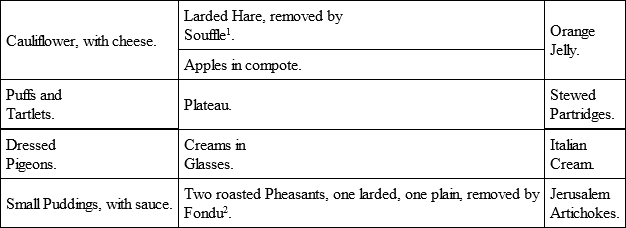
1. Light sweet Pudding.
2. Melted Cheese.
Remove the wholeThird Course
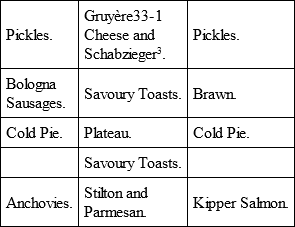
3. Swiss cheeses.
Radishes, cucumbers, salad, butter, &c. to be handed from the side tableDessert
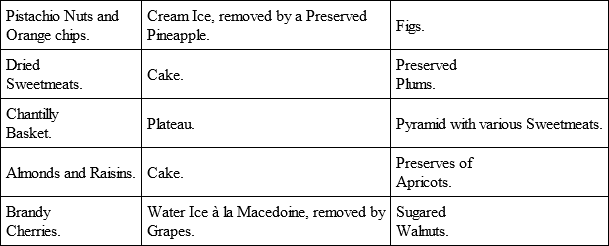
DINNER FOR TWELVE OR FOURTEEN PERSONS
First Course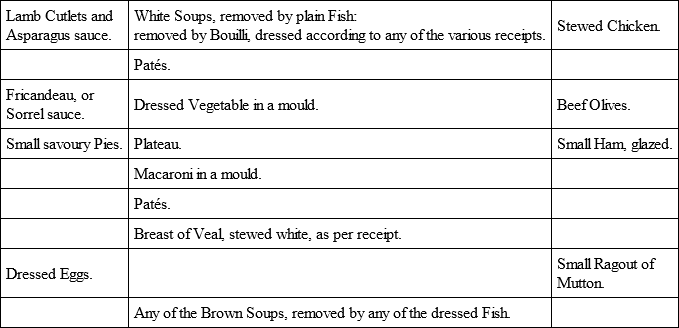
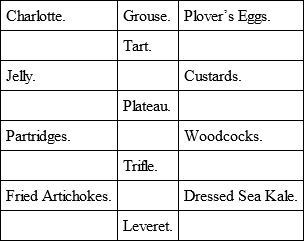
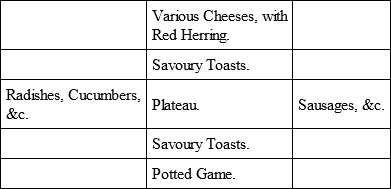
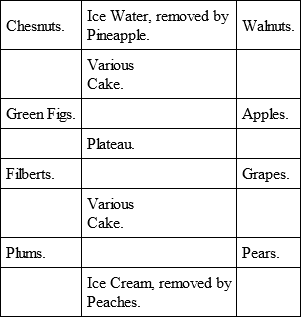
DINNER FOR TEN OR TWELVE PERSONS
First Course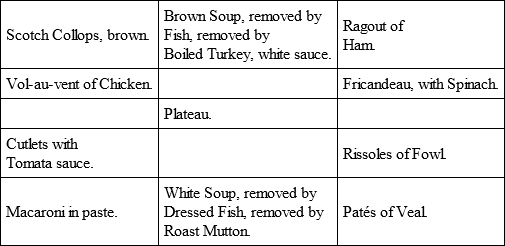

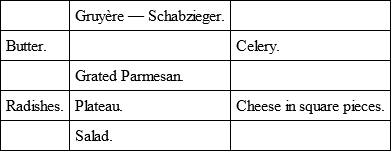
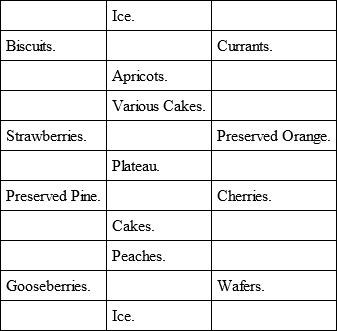
DINNER FOR EIGHT PERSONS
First Course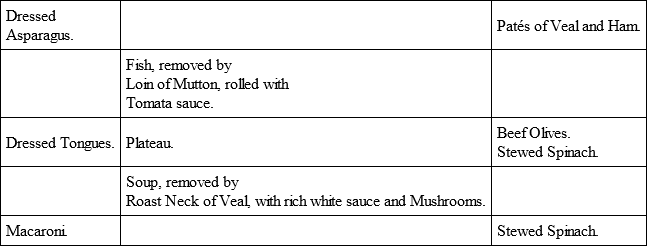
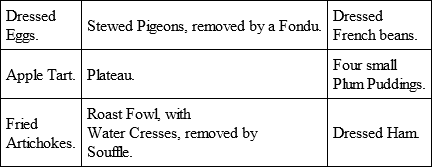
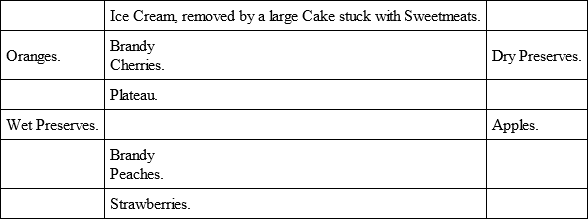
DINNER FOR SIX PERSONS
First Course





